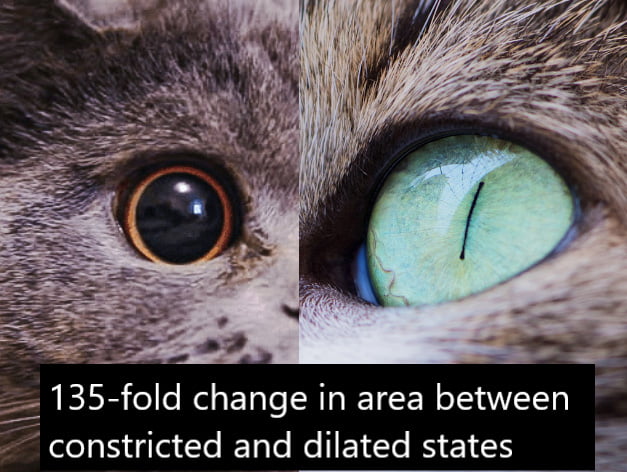This is a much-discussed topic but it is also a complicated topic. Only fairly recently have scientists successfully grappled with understanding the science behind the anatomy of the domestic cat’s eye. In my opinion, there are three reasons why cats’ eyes contract to a vertical slit.

First reason
The first reason is to do with the amount of light entering the eye and impacting upon the retina. This is described as retinal illumination or retinal illuminance.
Retinal illumination in the cat’s eye exceeds that in the human eye by about two times at high light intensities and approximately four times at low light intensities below 1 mL. This means that the amount of light impacting the retina is substantially greater in domestic cat than it is in humans (source: study: Variation in the size of the cat’s pupil as a function of stimulus brightness – https://doi.org/10.1037/h0062281).
To that we have to add the fact that domestic cat’s eyes require one sixth of the amount of light in low-light levels to see the same amount of detail and clarity as humans. Their eyes are more sensitive in lowlight conditions. Therefore, their eyes need protecting in bright light conditions.

Reducing the pupils to slits rather than tiny circles provide the domestic cat with a more refined control mechanism over how much light enters their eyes.
The reason why slits allow for a greater control of the light entering the eye and impinging upon the retina is because they can block light out in a controlled manner by the movement of their eyelid over that vertical slit. As the eyelid passes over it and progresses down the slit less and less light enters the retina. The eyelid works in conjunction with the narrowing of the slit to protect the retina. To put it another way, the eyelid operates horizontally and the slit operates vertically and they work in conjunction with each other.
This is in contrast to tigers. They have circular pupils. Domestic cats are mainly but not exclusively crepuscular hunters meaning that they hunt in the lowlight conditions at dawn and dusk whereas tigers are daytime killers. They don’t need quite the same level of sensitivity in their eyesight which in turn requires added protection during bright light conditions.
This leads me to the next point as to why domestic cats have vertical slits for pupils.
Second reason
Vertical pupil slits have evolved to improve the hunting success rate of ambush predators. Vertical slits allow ambush predators to better gauge the distance between themselves and their prey.
Vertical slits place objects not in the plane of focus i.e. the prey animal, more out of focus which helps to visually isolate the prey animal making their image clearer to the predator. The vertical-slit pupils maximises both blur in front and behind the object being focused upon. To this you have to add, of course, binocular vision. Like humans, we know that domestic cats have binocular vision, which allows them to measure distance. It is why, incidentally, you see cats moving their head from left to right sometimes when preying upon an animal. This is an added refinement to measuring distance between themselves and the prey animal.
Third reason
Contracting the pupil to a vertical slit from the wide-open circular aperture allows for a 135-fold change in area between constricted and dilated states. In humans there is a 15-fold change. So, the vertical slit allows for a greater control in the amount of light entering the eye. This is part and parcel of the need to see in lowlight conditions while protecting the eye and seeing well in bright conditions.
In conclusion, therefore, the vertical slit of the domestic cat pupil exists for three reasons: to protect the eye from bright light, to improve their hunting success rate and to provide a greater change in area between constricted and dilated states. The three reasons overlap.

